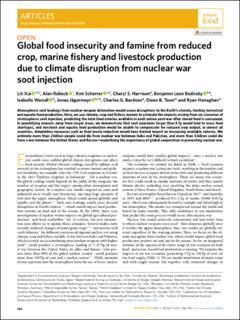| dc.contributor.author | Xia, Lili | |
| dc.contributor.author | Robock, Alan | |
| dc.contributor.author | Scherrer, Kim Josefin Niklasdotter | |
| dc.contributor.author | Harrison, Cheryl S. | |
| dc.contributor.author | Bodirsky, Benjamin Leon | |
| dc.contributor.author | Weindl, Isabelle | |
| dc.contributor.author | Jägermeyr, Jonas | |
| dc.contributor.author | Bardeen, Charles G. | |
| dc.contributor.author | Toon, Owen B. | |
| dc.contributor.author | Heneghan, Ryan | |
| dc.date.accessioned | 2022-12-22T15:06:20Z | |
| dc.date.available | 2022-12-22T15:06:20Z | |
| dc.date.created | 2022-11-03T14:43:49Z | |
| dc.date.issued | 2022 | |
| dc.identifier.issn | 2662-1355 | |
| dc.identifier.uri | https://hdl.handle.net/11250/3039288 | |
| dc.description.abstract | Atmospheric soot loadings from nuclear weapon detonation would cause disruptions to the Earth’s climate, limiting terrestrial and aquatic food production. Here, we use climate, crop and fishery models to estimate the impacts arising from six scenarios of stratospheric soot injection, predicting the total food calories available in each nation post-war after stored food is consumed. In quantifying impacts away from target areas, we demonstrate that soot injections larger than 5 Tg would lead to mass food shortages, and livestock and aquatic food production would be unable to compensate for reduced crop output, in almost all countries. Adaptation measures such as food waste reduction would have limited impact on increasing available calories. We estimate more than 2 billion people could die from nuclear war between India and Pakistan, and more than 5 billion could die from a war between the United States and Russia—underlining the importance of global cooperation in preventing nuclear war. | en_US |
| dc.language.iso | eng | en_US |
| dc.publisher | Springer Nature | en_US |
| dc.rights | Navngivelse 4.0 Internasjonal | * |
| dc.rights.uri | http://creativecommons.org/licenses/by/4.0/deed.no | * |
| dc.title | Global food insecurity and famine from reduced crop, marine fishery and livestock production due to climate disruption from nuclear war soot injection | en_US |
| dc.type | Journal article | en_US |
| dc.type | Peer reviewed | en_US |
| dc.description.version | publishedVersion | en_US |
| dc.rights.holder | Copyright 2022 the authors | en_US |
| cristin.ispublished | true | |
| cristin.fulltext | original | |
| cristin.qualitycode | 1 | |
| dc.identifier.doi | 10.1038/s43016-022-00573-0 | |
| dc.identifier.cristin | 2068723 | |
| dc.source.journal | Nature Food | en_US |
| dc.source.pagenumber | 586-596 | en_US |
| dc.relation.project | EC/H2020/682602 | en_US |
| dc.relation.project | Norges forskningsråd: 326896 | en_US |
| dc.identifier.citation | Nature Food. 2022, 3 (8), 586-596. | en_US |
| dc.source.volume | 3 | en_US |
| dc.source.issue | 8 | en_US |

